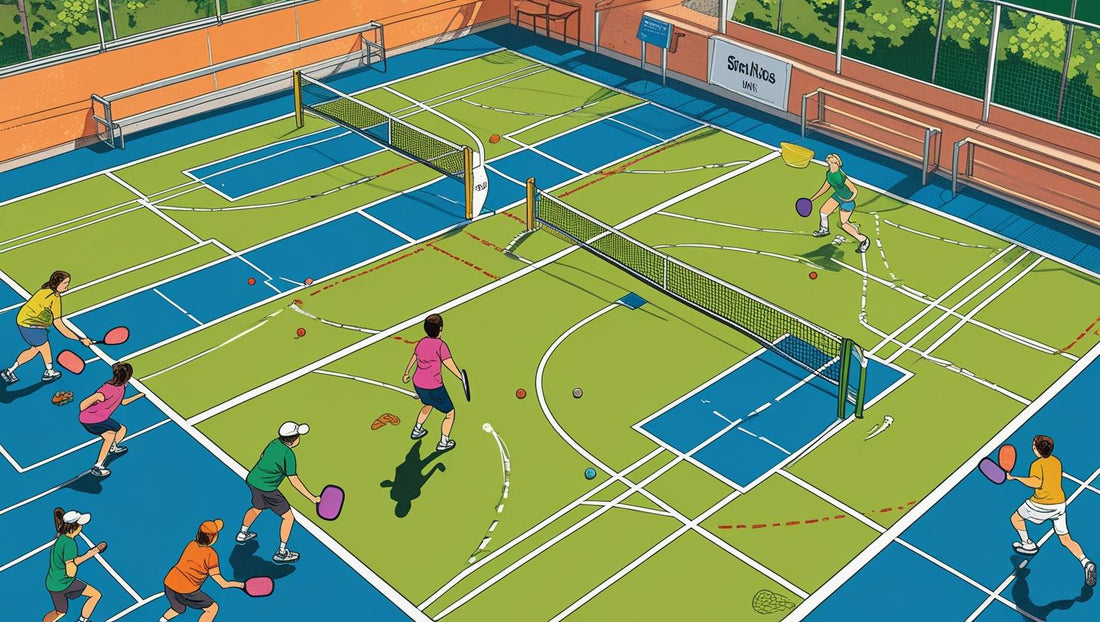
Breaking Down Pickleball Rules | What Every Player Should Understand
Share
Pickleball has the highest growth rate of paddling games in the U.S.,The sport is loved by players for its easy play and its social appeal as well as its simple learning curve. But, as with any other sport, understanding pickleball rules is essential for playing confidently and winning consistently.
If you're just beginning to learn how to play pickleball, or preparing for an event, understanding the rules can help you increase your performance.
Let’s break down everything you need to know about pickleball starting with serving rules, the double bounce rule, and the all-important kitchen zone
Pickleball Court and Equipment: Know the Setup
Standard Pickleball Court Dimensions
- Size: 20 feet wide x 44 feet long
- Net Height: 36" at the sidelines, 34" in the center
-
The court is divided into 3 main areas:the baseline area, the zone that is not used for volleyball (kitchen) and service courts..
Paddle and Ball
-
Paddles are constructed of composite or wood as well as carbon fiber.
-
Balls are made of plastic and have holes - like wiffle balls.
Explore premium pickleball paddles designed for players of all levels at GatorStrike.
Pickleball Serving Rules Explained
Legal Serve Guidelines
-
It must be hit just below the waist.
- At least one of the feet must remain in the baseline position during the serve.
-
The ball has to be served diagonally to the service court of the opponent.
Double Serving Rule
-
When playing doubles, the two players serve, before surrendering the serve.
-
When playing singles, the players swap side after scoring but receive one serving.
What Is a Let Serve?
-
If the ball lands on the net, but is landed in the right area of service the ball is considered allowed to serve and you can replay the serve.
Understanding the Double-Bounce Rule
This is among the most misunderstood, but vital rules in pickleball: rules:
-
The team that is receiving the ball must allow the ball to bounce for a few seconds before hitting it.
-
The team serving must allow the return bounce to settle prior to playing the return.
After that the volleys are permitted.
The Non-Volley Zone (The “Kitchen”)
The kitchen area is 7 feet across one side and the other. When in this zone:
-
It's impossible to play volley (hit the ball with the air).
-
In the kitchen, when you're volleying is a blunder.
-
You are able to enter the kitchen to practice groundstrokes following the ball that has bounced.
This prevents aggressive play on the net.
Common Pickleball Faults
These are the mistakes you should avoid:
-
Serving outside of boundaries or on the internet.
-
Volleying outside of the non-volley zone.
-
The double-bounce rule is not being followed.
-
The net or the post while playing.
-
The ball should bounce twice to your side.
Pro Tip: Learn the rules of the line! If the ball lands on any line, it's thought to be to be in.
How Scoring Works in Pickleball
-
Only the serving team is able to score points.
-
Games are usually played until 11. The winner is 2.
-
Points are awarded in the event that the team opposing you:
-
He hits the ball out
-
Makes a mistake
-
The ball is not returned or missed.
Bonus Tips to Master the Rules
Practice Regularly
Repetition creates muscle memory rules that become automatic the more you practice.
Play with Experienced Players
You'll gain real-time insight and gain knowledge through games.
Watch Tournaments
Watch how pros tackle mistakes, serves and kitchen rules.
Look up the official websites like USA Pickleball for the most recent rules changes along with scoring rules.
Final Thoughts: Respect the Rules, Enjoy the Game
Be aware that pickleball rules will make for a safer, enjoyable space that is safe and secure for players. It can also give you an advantage in your games.
If you're playing in an area park or are preparing for the next tournament, make sure you know the basics: serves and volleys, scoring along with the kitchen.
Are you ready to up your game?
Go to GatorStrike for the best tennis paddles, shoes nets and other accessories to help take your court play to the highest step
FAQs
1. What is the double-bounce rule in pickleball?
Each team has to have the ball bounce one time before volleys are permitted. This will ensure fair rallies and games that are based on strategy.
2. Can you step into the kitchen after hitting a volley?
No. Intruding into the non-volley zone following a volley or after the game is a violation.
3. How is serving different in singles vs doubles?
In singles, players get one serving before switching. In doubles, every player has an opportunity to serve prior to changing it.
4. How many points do you need to win?
Typically, 11 points are required and you must be able to win at least 2.
5. Can the ball touch the line and still be in?
Yes! Line-touching ball are back.












